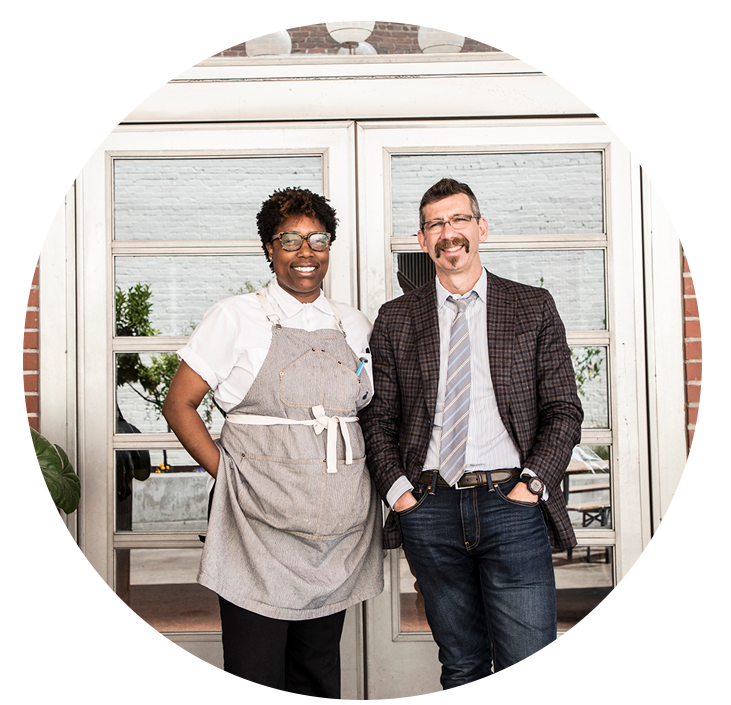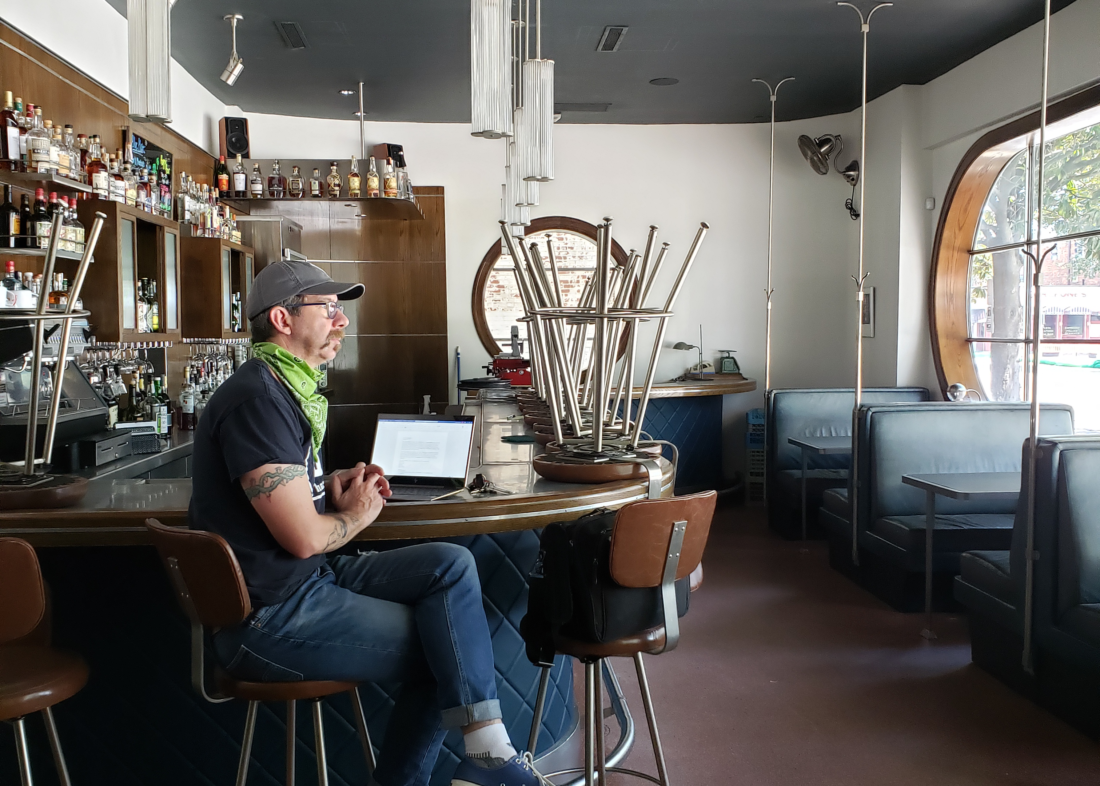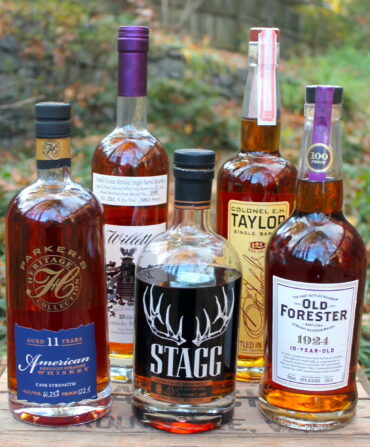Since the pandemic took over in mid-March, each morning, with my large brown dogs in tow, I walk to the Grey as I have been doing since 2012, the year we began the restoration project of the old Greyhound bus terminal in Savannah, Georgia, that houses our restaurant. I go there because, frankly, I don’t know what else to do or where else to go. I set up my laptop on the bar that hasn’t seen a drink placed on it in more than six weeks, other than the plastic cups of wine I overpour for myself each evening as I am finishing my day. There I sit, and I do the things that out-of-work restaurateurs do.

I fill out applications for loans. I do media interviews. I join coalitions to save restaurants. I blow the live oak leaves that have dropped onto the sidewalk out front into the road, Martin Luther King Junior Boulevard, so it looks like someone still cares, because I do care very much. The Grey, beyond my wife, my family, and my dogs, is my everything. I think about my business partner, Mashama Bailey, the Grey’s executive chef. I think about our team. What will they do if we fail because of this crisis? What will I do? I think about our stoves and refrigerators that never get used anymore, and I wonder if the equipment is feeling sorry for itself because its raison d’etre is gone. I pulled the plug on our big neon sign announcing “The Grey,” so I am never tricked into thinking we are open.
Last week, after Georgia’s governor, Brian Kemp, announced that restaurants would be allowed to reopen on April 27, we announced that the Grey and the Grey Market, our second Savannah restaurant, would remain closed.
For us this was not a difficult decision. Before we even had to consider ethics or safety, the economics of it were obvious to us. To open a restaurant, you have to have guests. Otherwise, it’s financial suicide. Mashama and I just don’t think they are going to come right now. The economics are different for some places that have received loans under the Paycheck Protection Program (PPP) because part of the value proposition of that program is that you have to pay your staff for that money to become forgivable.
We, too, applied for PPP funds as soon as our bank would allow and have been approved, though we have yet to receive any money. But in a way it matters not, as the PPP missed the point when it comes to restaurants and how we operate. What exactly are we staffing up to do? It’s back to that guest thing. Without guests, there is no point in bringing staff back on board to serve no one. And it is not just the next eight weeks that are important to our survival, as the PPP dictates how its funds are to be used, but the next eight months (or more) as we attempt to recover from all of this.
Similarly, the governor’s directive also doesn’t seem to take into account how restaurants operate. Though we’re allowed to reopen, he imposed restrictions that make it economically impossible for us to do so and extended the state of emergency in Georgia through sometime in June. Meanwhile, federal guidelines, if followed, would say that we cannot open, and the mayor of our city has advised us to remain closed. We agree with him.
All of this mixed messaging, in addition to just making one’s head spin, erodes the public’s confidence and creates factions. If you wear a mask and stay closed, you’re a bleeding heart who would rather let the economy die than do the right thing for our country. If you open your establishment and a mask isn’t for you, you’re someone who only cares about yourself and not the lives of your neighbors.
And where there is division and a lack of confidence, fear ensues. My fear is that the result of the conflicting directives will be a lengthening of this period that feels like the space between purgatory and hell.
Earlier last week, we had a video chat with our team. Like everybody else it seems, we purchased a Zoom account, and every other Monday we invite our furloughed employees to become a video box on one another’s screens so we can share our thoughts and, yes, our feelings.
Last week, on the day Georgia restaurants were allowed to reopen, we asked our folks a few simple questions:
“Would you personally dine in a restaurant tonight?”
“No,” came the answer. It was unanimous.
“Had we called you and said you should come back to work today, would you have come?”
“No,” they repeated. It was unanimous.
“When do you think you will feel comfortable coming back to work?”
“Not sure. Maybe in a few weeks.” It was unanimous.
These answers were exactly in line with how Mashama and I felt, too. She and I are not ready to go back. We feel it is still too soon. But our economics, our feelings, our comfort levels, and our team are unique to us.

Every business has its own set of circumstances, and some have chosen to open. I have faith in my restaurant colleagues. Restaurant people care about their teams and guests above all else, and I am sure the folks who chose to open did so with safety as their top priority. Ultimately, there is no way to exit this crisis without personal risk, and at some stage we will all have to take some to reopen. The question for us and the restaurants that remain closed is when is the right time?
But regardless of whether your local restaurant is open or closed right now, all independent restaurants are in deep, deep trouble. All of us. Any business that went from being successful to having zero revenue for six weeks or longer is going to be in trouble. Any business that is going to have sales that are significantly depressed for months, if not years, following its reopening is going to be in trouble. I know that a lot of small (and large) businesses currently fall into that category, and I feel for each of those entrepreneurs and owners. There is a camaraderie among those of us who do stuff like this for a living, who risk a lot to follow our passions and serve our communities. We should all care about and empathize with everyone negatively impacted.
But you should really, truly care about local, independent restaurants and their survival. Here’s why:
First, on average somewhere between 85 and 95 cents of every dollar spent at an independent restaurant goes right back into the community. This is an enormously high percentage of revenue that directly impacts local economies. These monies are paid out in the form of wages and purchases from local farmers, ranchers, and dairies. These monies secure the contracts with local HVAC companies, the exterminator, the handyman, the young woman driving the beer delivery truck, the guy who cleans the smelly grease trap, and the kid who fixes the wireless network. These monies pay the rent to the small landlord, the mortgages at the local bank, and the property taxes that support our schools.
Second, the 500,000 independent restaurants in America employ 11 million people. That is almost 7 percent of the entire U.S. workforce. That makes local restaurants a larger employer than Walmart, the biggest single employer in the country, by a factor of seven.
And if those quantitative reasons are not enough, think about your best memories, ever.
What were you eating? What were you drinking? Where were you doing it?
For my wedding anniversary this past year, I was eating penne arrabiata at 5:30 p.m. because that is the only time you don’t have to wait for a table at Emilio’s Ballato, an institution on Houston Street in lower Manhattan. My wife had Bolognese as her dinner, and we split a meatball and sautéed broccoli rabe to start. We shared an insalata mista after our mains. We drank a bottle of Barolo and shouted across the room with Emilio, the owner and a hulking Italian guy who was sitting in his usual chair at the first table just next to the front door—the chair I have seen him sitting in for the nearly thirty years I have been going to his joint.
“It’s our anniversary,” I yelled.
He smiled. “How long?” he asked gruffly.
“Twenty-three years,” I shouted back over the heads of the other guests, who were used to the communication lines in Emilio’s restaurant.
He smiled again, our interaction completed.
At some point during the meal, he dropped a small plate of spaghetti on our table, acknowledging our celebration, and said, “Taste this. Tell me what you think.”
Our night was made because of his kindness.
We had an espresso and a sambuca to finish the evening and strolled the streets of New York, abundantly satisfied.
Food is culture, community, and life. It is hospitality, kindness, and warmth. It is what binds us, even when we are divided. It is the glue, the fabric, the how, and the why people come together. Food is one of the reasons we travel to places like New Orleans, Savannah, New York, Paris, Rome, Tokyo, and Hong Kong. Even if you don’t go to restaurants much yourself, think about your village, your town, your city, your community, and I think you will agree that restaurants are key to its vibrancy, its economic development, and its social infrastructure.
All of that is in jeopardy right now. And that is the real reason why you should care very much about local restaurants.
So, if you have a minute, call your senator or representative. Tweet at them. Facebook them. And tell them this: Save restaurants! Whether they are currently open or closed.








